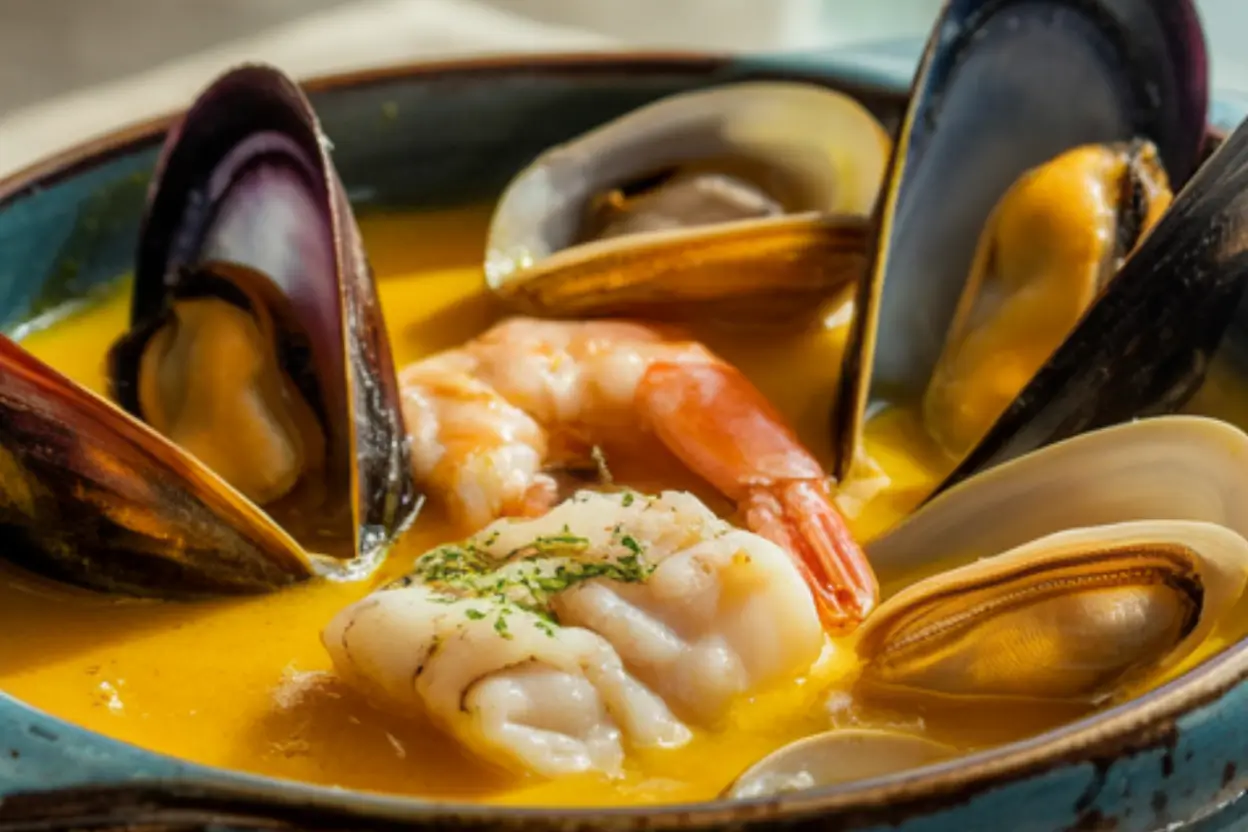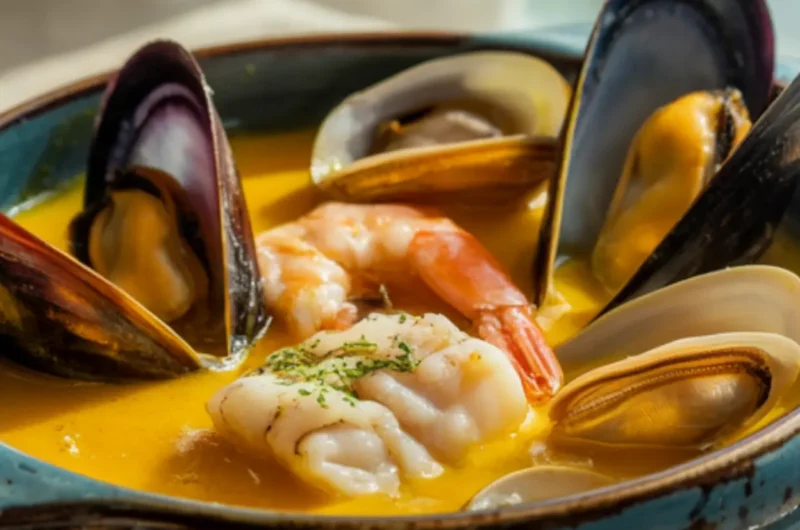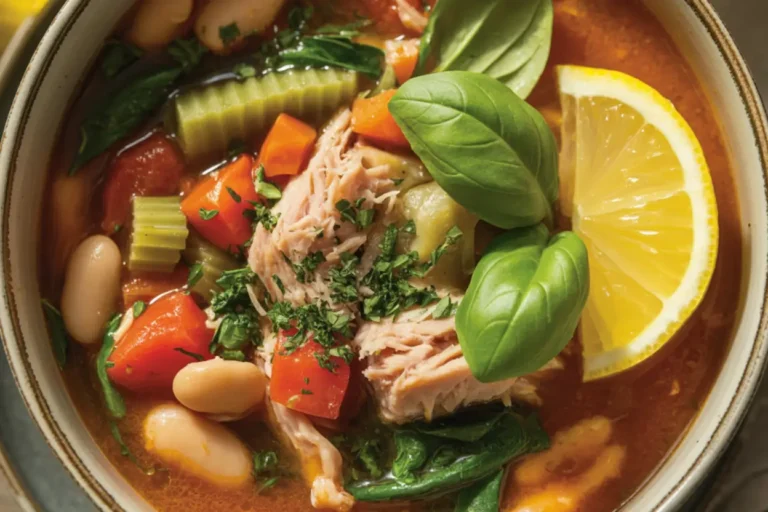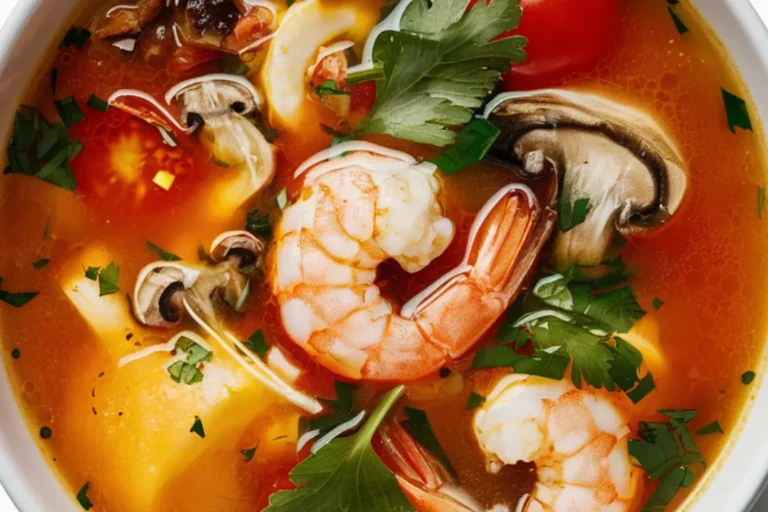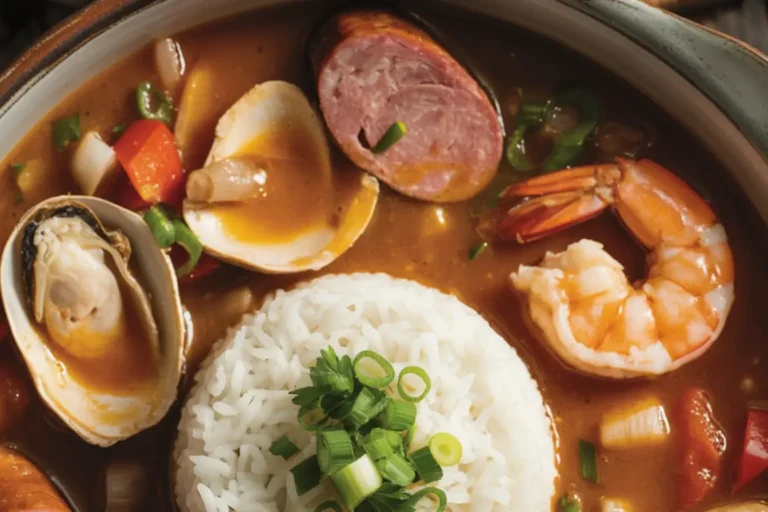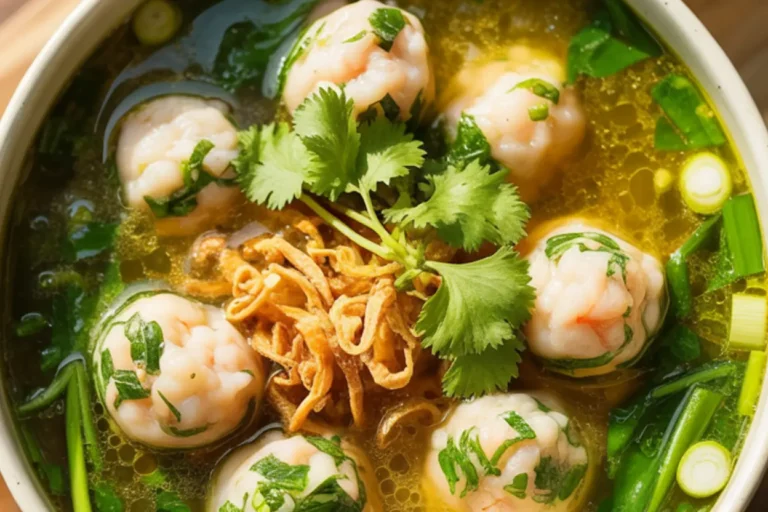Bouillabaisse Recipe: How 40 Minutes Can Make Magic Happen
Table of Contents
How to Make Bouillabaisse:
Quick Overview
Thank you for reading this post, don't forget to subscribe!Traditionally, bouillabaisse is a labor-intensive dish that fishermen created to use up the bony rockfish they couldn’t sell to restaurants. Over time, it evolved into the celebrated seafood stew we know today. My 20-minute version maintains the soul of this Provençal classic but simplifies the process dramatically.
This quick bouillabaisse features a saffron-infused broth that’s incredibly aromatic and flavorful. The combination of various seafood—white fish, shrimp, mussels, and clams—creates a delightful medley of textures and tastes. What makes this recipe a weeknight wonder is how quickly it comes together; most of the preparation is just chopping vegetables, and the actual cooking takes merely 20 minutes. The result is a rich, satisfying stew that tastes like it’s been simmering all day.
The secret to this shortened cooking time lies in building layers of flavor quickly and using a few shortcuts that don’t compromise the authentic taste. You’ll be amazed at how a few simple techniques can create such a complex and satisfying dish in record time.
The Ingredients I Use to Bring My Bouillabaisse to Life
For this streamlined bouillabaisse recipe, you’ll need:
For the Broth:
- 3 tablespoons olive oil
- 1 large onion, finely diced
- 1 leek, using only the white and light green parts, cleaned and thinly sliced
- 4 garlic cloves, minced
- 1 fennel bulb, cored and thinly sliced (reserve some fronds for garnish)
- 1 tablespoon tomato paste
- 1 can (14 oz) diced tomatoes
- 1 strip of orange peel (use a vegetable peeler to remove just the zest)
- 2 bay leaves
- 1 teaspoon dried thyme
- ¼ teaspoon crushed red pepper flakes
- 1 pinch (about ¼ teaspoon) saffron threads
- 1 cup dry white wine
- 4 cups seafood or fish stock (store-bought is fine for this quick version)
- Salt and freshly ground black pepper to taste
For the Seafood:
- ½ pound firm white fish (such as cod, halibut, or sea bass), cut into 2-inch pieces
- ½ pound large shrimp, peeled and deveined
- ½ pound mussels, scrubbed and debearded
- ½ pound clams, scrubbed
For Serving:
- 2 tablespoons fresh parsley, chopped
- Crusty French bread
- Rouille (traditional garlic and pepper sauce – optional, recipe below)
Step-by-Step Instructions
1. Prepare Your Ingredients
Before beginning, ensure all your seafood is properly cleaned and prepared. Pat the fish dry with paper towels and season lightly with salt and pepper. Clean the mussels and clams by scrubbing their shells under cold running water and removing the “beards” from the mussels (the stringy bits hanging out of the shell). Discard any shellfish with cracked shells or any that don’t close when tapped gently.
Having all your vegetables chopped and ready will make this quick-cooking process even smoother. The French call this mise en place (everything in its place), and it’s especially important for fast-cooking recipes like this one.
2. Build the Flavorful Base
Heat the olive oil in a large Dutch oven or heavy-bottomed pot over medium heat. Add the diced onion, sliced leek, and fennel. Sauté for about 5 minutes until they begin to soften but not brown. Add the minced garlic and continue cooking for another minute until fragrant.
Stir in the tomato paste and cook for one minute to caramelize it slightly, which will add depth to your broth. This quick step might seem minor, but it helps build those complex flavors that make people think your bouillabaisse has been simmering all day.
3. Create the Aromatic Broth
Add the canned tomatoes (with their juices), orange peel, bay leaves, dried thyme, red pepper flakes, and saffron threads to the pot. The saffron is non-negotiable here—it’s what gives bouillabaisse its distinctive flavor and golden color. Pour in the white wine and let it bubble for 2 minutes to burn off the alcohol and concentrate the flavors.
Pour in the seafood stock and bring the mixture to a gentle boil. Reduce the heat and simmer uncovered for about 10 minutes to allow the flavors to meld. This relatively brief simmering time is enough to extract flavor from the aromatics while keeping our total cooking time to just 20 minutes.
4. Cook the Seafood
This is where timing becomes crucial. You’ll add the seafood in stages, starting with the items that take the longest to cook:
- First, add the firm white fish pieces to the simmering broth and cook for 2 minutes.
- Next, add the shrimp, mussels, and clams. Cover the pot and continue to simmer for about 4-5 minutes, until the shrimp have turned pink and the shellfish have opened. Discard any mussels or clams that remain closed after cooking.
Be careful not to overcook the seafood—it should be just cooked through. Overcooked seafood becomes tough and rubbery, which would undermine all the beautiful flavors you’ve developed.
5. Finish and Serve
Taste the broth and season with salt and pepper as needed. Gently stir in the chopped parsley, reserving a little for garnish. Ladle the bouillabaisse into wide, shallow bowls, making sure each serving gets a good variety of seafood. Garnish with the reserved parsley and fennel fronds.
Traditionally, bouillabaisse is served with crusty bread and rouille, a garlicky pepper sauce that’s spread on the bread and then dipped into the broth or allowed to melt into the stew. For a quick rouille, blend ½ cup mayonnaise with 2 minced garlic cloves, a pinch of saffron, ¼ teaspoon cayenne pepper, and a squeeze of lemon juice.
What to Serve Bouillabaisse With
While bouillabaisse is certainly substantial enough to be a meal on its own, there are several accompaniments that can enhance the experience:
- Crusty French Baguette: Absolutely essential for soaking up the flavorful broth. Toast slices lightly and rub them with a cut garlic clove for extra flavor.
- Rouille: This traditional garlic and red pepper sauce is spread on bread and then dipped into the broth. It adds another layer of flavor that complements the seafood beautifully.
- Simple Green Salad: A light salad dressed with a basic vinaigrette provides a refreshing contrast to the rich stew. Consider a mix of butter lettuce, frisée, and herbs like chervil or tarragon.
- Dry White Wine: A crisp Provençal wine like a Cassis Blanc or a dry Vermentino from the nearby Italian Riviera makes the perfect pairing. If those aren’t available, any dry, unoaked white wine like Sauvignon Blanc or Pinot Grigio will work well.
- Chilled Pastis: For an authentically Provençal experience, serve this anise-flavored aperitif as a pre-dinner drink.
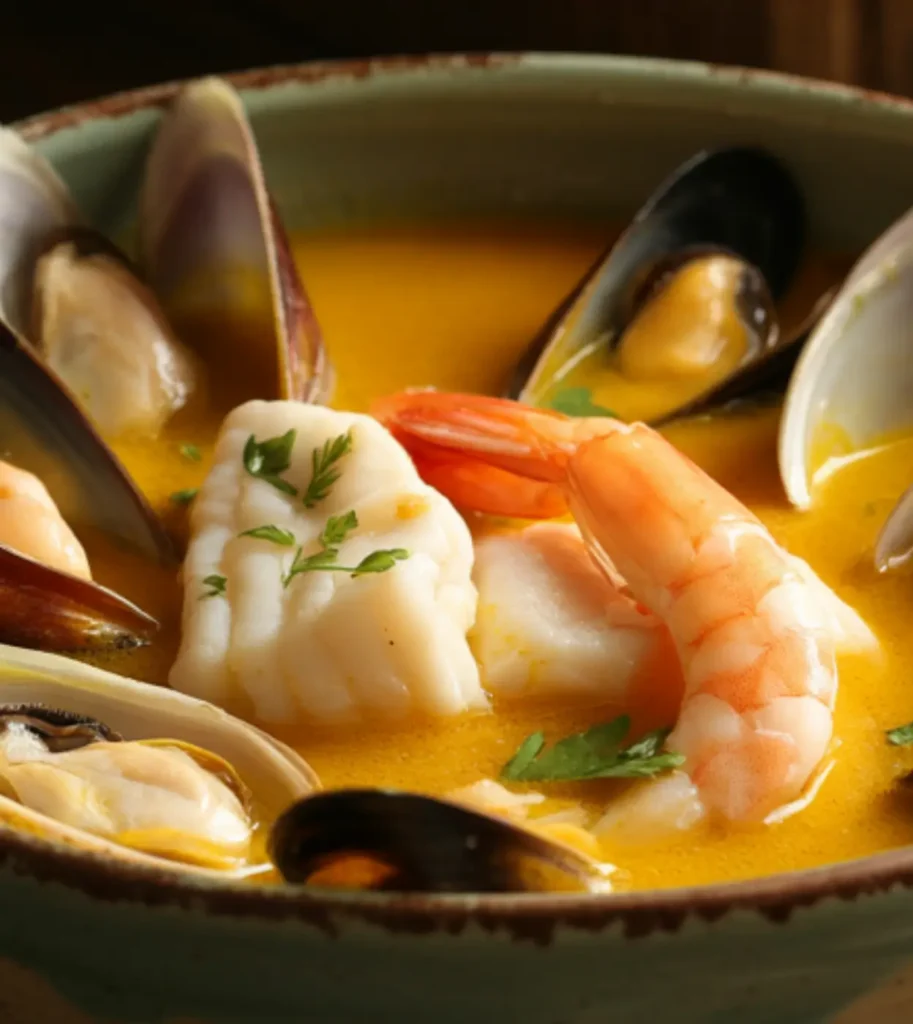
Top Tips for Perfecting Bouillabaisse
After preparing this dish countless times, I’ve gathered some insights that can help you achieve the best results:
- Quality of Seafood: Since seafood is the star of this dish, freshness is paramount. Look for clear eyes and firm flesh in fish, and make sure shellfish are alive before cooking (shells should be closed or close when tapped).
- Seafood Substitutions: Don’t worry if you can’t find the exact seafood listed. Use whatever fresh seafood is available in your area. Just maintain approximately the same total quantity and adjust cooking times as needed (thicker fish fillets will require more time than thin ones).
- Saffron Alternatives: Saffron is expensive but essential for authentic flavor. However, if you absolutely can’t find or afford it, a pinch of turmeric mixed with a tiny bit of paprika can provide similar color, though not the same unique flavor.
- Homemade Fish Stock: If you have time, making your own fish stock from fish bones and shrimp shells dramatically improves the flavor. You can make this ahead and freeze it.
- Wine Selection: Cook with a wine you would enjoy drinking. The flavor concentrates as it cooks, so a poor-quality wine will negatively impact your bouillabaisse.
- Layering Flavors: Don’t rush the initial steps of sautéing the vegetables and building the broth base. These steps create the foundation of flavor that makes the quick-cooking method work so well.
- Seafood Cooking Order: Always add seafood in order of cooking time required, starting with the items that take the longest. This prevents some pieces from becoming overcooked while waiting for others to finish.
Storing and Reheating Tips
Ideally, bouillabaisse should be enjoyed immediately after cooking. However, if you do have leftovers, here’s how to handle them:
Storing: Separate the broth from the seafood before storing. Place the broth in an airtight container and refrigerate for up to 2 days. For the seafood, remove shellfish from their shells (discard the shells) and store all seafood together in a separate airtight container for up to 1 day. The seafood won’t hold up as well as the broth, so plan to consume it sooner.
Freezing: While I generally don’t recommend freezing seafood that’s already been cooked, the broth freezes beautifully. Store it in airtight containers or heavy-duty freezer bags for up to 3 months. When ready to use, thaw overnight in the refrigerator before reheating.
Reheating: To reheat, warm the broth in a pot over medium-low heat until just simmering. Add the seafood during the last minute or two of heating, just long enough to warm it through without cooking it further. Overheating will make the seafood tough and rubbery.
Repurposing Leftovers: If you prefer not to reheat seafood, consider repurposing the broth into a new dish. It makes an excellent base for a seafood risotto or pasta sauce. Just add fresh seafood to the reheated broth instead of using the leftovers.
This 20-minute bouillabaisse recipe proves that you don’t need hours in the kitchen to create something truly magical. By focusing on building layers of flavor quickly and using a few clever shortcuts, you can enjoy this classic French seafood stew even on busy weeknights. The combination of saffron-infused broth and fresh seafood creates a dish that feels special enough for company but simple enough for everyday cooking. Bon appétit!
click here to follow me on pinterest
Bouillabaisse Recipe: How 40 Minutes Can Make Magic Happen
Cuisine: FrenchDifficulty: Moderate4
servings25
minutes40
minutes450-500
kcalBouillabaisse is a traditional Provençal seafood stew originating from the southern coast of France, particularly Marseille. This rich, aromatic dish features a medley of fish and shellfish simmered in a broth infused with saffron, fennel, white wine, and tomatoes, served with crusty French bread and often accompanied by rouille, a garlicky, peppery sauce.
Ingredients
3 tablespoons olive oil
1 large onion, finely diced
1 leek, using only the white and light green parts, cleaned and thinly sliced
4 garlic cloves, minced
1 fennel bulb, cored and thinly sliced (reserve some fronds for garnish)
1 tablespoon tomato paste
1 can (14 oz) diced tomatoes
1 strip of orange peel (use a vegetable peeler to remove just the zest)
2 bay leaves
1 teaspoon dried thyme
¼ teaspoon crushed red pepper flakes
1 pinch (about ¼ teaspoon) saffron threads
1 cup dry white wine
4 cups seafood or fish stock (store-bought is fine for this quick version)
Salt and freshly ground black pepper to taste
½ pound firm white fish (such as cod, halibut, or sea bass), cut into 2-inch pieces
½ pound large shrimp, peeled and deveined
½ pound mussels, scrubbed and debearded
½ pound clams, scrubbed
2 tablespoons fresh parsley, chopped
Crusty French bread
Rouille (traditional garlic and pepper sauce – optional, recipe below)
Instructions
- Prep the Ingredients
Clean and prep all seafood: pat fish dry and lightly season; scrub mussels and clams, discarding any damaged or unresponsive ones. Chop all vegetables in advance (mise en place) to streamline the cooking process. - Build the Flavor Base
In a large pot, heat olive oil over medium. Sauté onion, leek, and fennel for ~5 minutes until softened. Add garlic and cook 1 minute more. Stir in tomato paste and cook briefly to deepen the flavor. - Make the Broth
Add tomatoes (with juice), orange peel, bay leaves, thyme, red pepper flakes, and saffron. Pour in white wine, simmer 2 minutes. Add seafood stock and bring to a boil. Reduce heat and simmer uncovered for 10 minutes to blend flavors. - Cook the Seafood
Add white fish to the broth and cook for 2 minutes. Then add shrimp, mussels, and clams. Cover and simmer 4–5 minutes until shrimp are pink and shellfish open. Discard any that remain closed. - Finish and Serve
Taste and season with salt and pepper. Stir in chopped parsley. Serve in bowls with a mix of seafood and broth, garnished with reserved parsley and fennel fronds. Enjoy with crusty bread and rouille, if desired.
Notes
- Bouillabaisse may seem elaborate, but it’s rooted in simplicity and freshness. Originally a humble fisherman’s dish, it was made using the day’s unsellable catch. Feel free to mix and match seafood based on availability, just make sure it’s fresh. The key to authentic flavor lies in the saffron, fennel, and orange peel, which create the dish’s signature aromatic broth. Don’t skip the crusty bread, it’s perfect for soaking up every drop!

